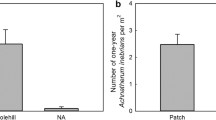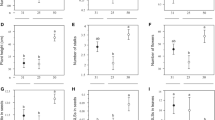Abstract
Fungal endophytes of grasses are often included in agricultural management and in ecological studies of natural grass populations. In European agriculture and ecological studies, however, grass endophytes are largely ignored. In this study, we determined endophyte infection frequencies of 13 European cultivars and 49 wild tall fescue (Schedonorus phoenix) populations in Northern Europe. We then examined seed production and seed predation of endophyte-infected (E+) and endophyte-free (E−) tall fescue (in wild grass populations and in a field experiment) and meadow fescue (Schedonorus pratensis; in a field experiment only). Endophytes were detected in only one of the 13 cultivars. In contrast, >90% of wild tall fescue plants harbored endophytes in 45 wild populations but were absent in three inland populations in Estonia. In three wild tall fescue study sites, 17%, 22%, and 56% of the seeds were preyed upon by the cocksfoot moth. Endophyte infection did not affect seed mass of tall fescue in the field experiment. However, seed predation was lower in E+ than E− grasses in the two tall fescue populations with higher predation rates. For meadow fescue, the mean number of seeds from E+ plants was higher than E− plants, but E− and E+ seeds had equal rates of predation by the moth. Our results suggest that the effects of grass endophytes on seed production and cocksfoot moth seed predation vary considerably among grass species, and the effects may depend on herbivore pressure and other environmental conditions.




Similar content being viewed by others
References
Carter DJ (1984) Pest Lepidoptera of Europe. Dr. W. Junk Publications, Boston, p 75
Cheplick GP, Faeth SH (2009) Ecology and evolution of the grass-endophyte symbiosis. Oxford University Press, Oxford
Chopra RL (1925) On the structure, life-history, economic importance and distribution of the cocksfoot moth, Glyphipteryx fischeriella. Zell Ann Appl Biol 12:359–397
Clay K (2009) Defensive mutualism and grass endophytes: still valid after all these years? In: Torres M, White JF (eds) Defensive mutualism in microbial symbiosis. Taylor and Francis Publications, London, pp 9–20
Clay K (1990) Fungal endophytes of grasses. Ann Rev Ecolog Syst 21:275–297
Clay K (1987) Effects of fungal endophytes on the seed and seedling biology of Lolium perenne and Festuca arundinacea. Oecolgia 73:358–362
Clay K, Holah J (1999) Fungal endophyte symbiosis and plant diversity in successional fields. Science 285:1742–1744
Clay K, Schardl C (2002) Evolutionary origins and ecological consequences of endophyte symbiosis with grasses. Am Nat 160:99–127
Elbersen HW, West CP (1996) Growth and water relations of field-grown tall fescue as influenced by drought and endophyte. Grass Forage Sci 51:333–342
Gibson DJ, Newman JA (2001) Festucal arundinacea Schreber (F. elatior L. ssp. arundinacea (Schreber) Hackel). J Ecol 89:304–324
Hemken RW, Boling JA, Bull LS, Hatton RH, Buckner RC, Bush LP (1981) Interaction of environmental temperature and anti-quality factors on the severity of summer fescue toxicosis. J Anim Sci 52:710
Hemken RW, Bull LS, Boling JA, Kane E, Bush LP, Buckner RC (1979) Summer fescue toxicosis in lactating cows and sheep fed experimental strains of regrass-tall fescue hybrids. J Anim Sci 49:641
Hoveland CS (1993) Importance and economic-significance of the acremonium endophytes to performance of animals and grass plant. Agri Ecol Envi 44:3–12
Huitu O, Helander M, Lehtonen P, Saikkonen K (2008) Consumption of grass endophytes alters the ultraviolet spectrum of vole urine. Oecologia 156:333–340
Hämet-Ahti L, Suominen J, Ulvinen T, Uotila P (eds) (1998) Retkeilykasvio (Field Flora of Finland, in Finnish), 4th edn. Finnish Museum of Natural History, Finland, pp 656
Knoch TR, Faeth SH, Arnott DL (1993) Endophytic fungi alter foraging and dispersal by desert seed-harvesting ants. Oecologia 95:470–473
Lehtonen P, Helander M, Saikkonen K (2005) Are endophyte-mediated effects on herbivores conditional on soil nutrients? Oecologia 142:38–45
Madej CW, Clay K (1991) Avian seed preference and weight-loss experiments—the effect of fungal endophyte-infected tall fescue seeds. Oecologia 88:296–302
Malinowski DP, Belesky DP (2000) Adaptations of endophyte-infected cool-season grasses to environmental stresses: mechanisms of drought and mineral stress tolerance. Crop Sci 40:923–940
Niemeläinen O, Jauhiainen L, Miettinen E (2001) Yield profile of tall fescue (Festuca arundinacea) in comparison with meadow fescue (F. pratensis) in Finland. Grass Forage Sci 56:249–258
Pecetti L, Romani M, Annicchiarico P, Piano E (2008) Tall fescue adaptation to low nitrogen fertilization in relation to germplasm type and endophyte infection. J Agron Crop Sci 194:244–247
Pecetti L, Romani M, Carroni AM, Annicchiarico P, Piano E (2007) The effect of endophyte infection on persistence of tall fescue (Festuca arundinacea Schreb.) populations in two climatically contrasting Italian locations. Aust J Agric Res 58:893–899
Piano E, Bertoli FB, Romani M, Tava A, Riccioni L, Valvassori M, Carroni AM, Pecetti L (2005) Specificity of host-endophyte association in tall fescue populations from Sardinia, Italy. Crop Sci 45:1456–1463
Puentes A, Bazely DR, Huss-Danell K (2007) Endophytic fungi in Festuca pratensis grown in Swedish agricultural grasslands with different managements. Symbiosis 44:121–126
Ravel C, Michalakis Y, Charmet G (1997) The effect of imperfect transmission on the frequency of mutualistic seed-borne endophytes in natural populations of grasses. Oikos 80:18–24
Rolston MP, Hare MD, Moore KK, Christensen MJ (1986) Viability of Lolium endophyte fungus in seed stored at different moisture conditions and temperatures. NZ J Exp Agric 14:297–300
Rudgers JA, Afkhami ME, Rúa MA, Davitt AJ, Hammer S, Huguet VM (2009) A fungus among us: broad patterns of endophyte distribution in the grasses. J Ecol 90:1531–1539
Saari S, Lehtonen P, Helander M, Saikkonen K (2009) High variation in frequency of infection by endophytes in cultivars of meadow fescue in Finland. Grass Forage Sci 64:169–176
Saha DC, Jackson MA, Johnson-Cicalese JM (1988) A rapid staining method for detection of endophytic fungi in turf and forage grasses. Phytopathology 2:237–239
Saikkonen K, Ahlholm J, Helander M, Lehtimäki S, Niemeläinen O (2000) Endophytic fungi in wild and cultivated grasses in Finland. Ecography 23:360–366
Saikkonen K, Gyllenberg M, Ion D (2002) The persistence of fungal endophytes in structured grass metapopulations. Proc R Soc Lond B 269:1397–1403
Saikkonen K, Lehtonen P, Helander M, Koricheva J, Faeth SH (2006) Model systems in ecology: dissecting the endophyte-grass literature. Trends Plant Sci 11:428–433
Saikkonen K, Saari S, Helander M (2010) Defensive mutualism between plants and endophytic fungi? Fungal Divers 41:101–113
Saikkonen K, Wäli P, Helander M, Faeth SH (2004) Evolution of endophyte-plant symbioses. Trends Plant Sci 9:275–280
Schulthess FM, Faeth SH (1998) Distrubution, abundances, and associations of the endophytic fungal community of Arizona fescue (Festuca arizonica). Mycologia 90:569–578
Welty RE, Azevedo MD (1985) Survival of endophyte hyphae in seeds of tall fescue stored one year. Phytopathology 75:1331
Wäli PR, Ahlholm J, Helander M, Saikkonen K (2007) Occurrence and genetic structure of the systemic grass endophyte Epichloë festucae in fine fescue populations. Microb Ecol 53:20–29
Zabalgogeazcoa I, Bony S (2005) Neotyphodium research and application in Europe. In: Roberts CA, West CP, Spiders DE (eds) Neotyphodium in cool-season grasses. Blackwell Publishing, Ames, pp 23–33
Acknowledgements
This study was funded by the Academy of Finland (project no. 110658), Marjatta and Eino Kolli Foundation, Olvi Foundation, and Niemi Foundation.
Author information
Authors and Affiliations
Corresponding author
Rights and permissions
About this article
Cite this article
Saari, S., Helander, M., Faeth, S.H. et al. The Effects of Endophytes on Seed Production and Seed Predation of Tall Fescue and Meadow Fescue. Microb Ecol 60, 928–934 (2010). https://doi.org/10.1007/s00248-010-9749-8
Received:
Accepted:
Published:
Issue Date:
DOI: https://doi.org/10.1007/s00248-010-9749-8




